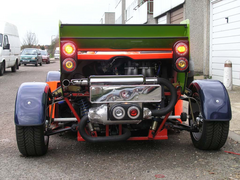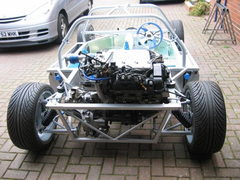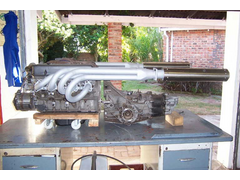
longitudinal vs. transverse
Pseicho - 19/1/07 at 04:03 PM
Let's say you have to drivetrains, a longitudinal one and a transverse one.
Apart from they're orientation they perform the same, cost the same, both are common.
Which is better? And especially, WHY?
Things I got already are:
Transverse:
+Compact
+Lighter
-Hard to build an independent rear suspension around (this is a very important point for me)
Longitudinal:
+Better f/r weight distribution
+Easier to upgrade to a big engine (i4 to V8)
- Longer wheelbase needed
nitram38 - 19/1/07 at 04:13 PM
Also depends on which end of the car they are mounted. Rear engine transverse will give better traction, but could be hard to catch in corners.
Most racing formula cars are rear engined for good balance.
It all depends on your driving style. Do you like to drive through corners with under or oversteer?
Your engine placement and wether front or rear wheel drive will affect both.
Rear engined transverse is easier to build suspension for as all you have are driveshafts from the gearbox.


Description
[Edited on 19/1/2007 by nitram38]
britishtrident - 19/1/07 at 04:31 PM
Most transverse engine-gearbox packages from front wheel drive cars have an inbuilt problem the transverse weight distribution is heavily biased
towards the the right side.
Especially for a UK right hand drive road sports car this is less than ideal.
ned - 19/1/07 at 04:55 PM
way out of my depth but I'm sure someone has mentioned polar moment of intertia or somesuch phrase in relation to how the spinning of the engine
effects erm something ??!!


jlparsons - 19/1/07 at 05:59 PM
In the car industry the decision is all about packaging these days. Transverse front usually wins because it needs little engine-bay space and needs
no transmission tunnel, so you have more volume to package the interior and stowage spaces. Everything else is a compromise around that, which to be
fair most car companies do extremely well these days.
RazMan - 19/1/07 at 06:25 PM
Personally I would go for longtitudinal - much better central weight distribution and the exhaust plumbing is much easier too (try making a header set
for a V6 transverse engine) Only downside is that you need a little more length to accomodate the gearbox.
suparuss - 19/1/07 at 06:28 PM
you forgot the other crieria-
longitudinal engines look cool, and rock the car from side to side when you rev it, which is also cool! good enough reason as any if you ask me.
seriously though- a longintudinal layout will usually put the engine futher into the middle of the car balancing front to rear weight distribution
where a transeverse setup puts the weight pretty much directly over the rear axle and so will also be slightly higher affecting roll centers. also you
have better rear supension options with a longitudinal but less front supension options because your legs tend to be in the way. with transverse the
rear becomes the problem because of the width of the engine seup. both are completely different kettles of fish and which you use will depend entirely
on what you want from the car and what kind of compromises you are willing to take.
[Edited on 19/1/07 by suparuss]
goodall - 19/1/07 at 08:38 PM
ah yes that glorious rocking motion as you rev the engine the best reason to go for north-south, also you can change your engine with more simplicity
with north-south because theres no drive shafts in the way
TheGecko - 19/1/07 at 11:36 PM
As someone who is (ever so slowly) building a middy with a transverse drivetrain, I'll chime in with a few comments.
- The weight distribution argument isn't as simple as many think. Most transverse drivetrains have pretty much all of their mass in front of
the axle line. Longitudinal ones only have the engine and clutch in front (usually) - the mass of the gearbox is hanging out the back. I suspect
that with a heavy inline box like a UN1 the mass centre of the whole drivetrain isn't really much further forward than an equivalent transverse
configuration.
- A transverse drivetrain is theoretically more efficient because there isn't a 90° direction change required at the differential.
- Transverse drivetrains are now ubiquitous. Common = cheap  And for builders (like us in Australia) who need to meet almost current emissions
rules, common & cheap is important.
And for builders (like us in Australia) who need to meet almost current emissions
rules, common & cheap is important.
At the end of the day, of course, it's up to each individual builder to use what suits them.
Dominic
kb58 - 20/1/07 at 01:13 AM
As one who used a Honda Prelude transverse drivetrain, I agree that the width does make it harder to use traditional A-arms.
I do feel, though, that they are, by far, the most logical drivetrain to use these days. It amuses me how much trouble people go through to convert
them to RWD so they can put them in a Seven.
My opinion is, just use a commonly available transverse drivetrain. The benefits far outweigh any disadvantages.
gttman - 20/1/07 at 09:16 AM
Power.....
Show me a cheap unstressed traverse engine that produces 300+bhp NA.
Of cause the idea is to make the car light but this will depend on the car you want to build... if its a lightweight motorbike alternative like a 7
then a light is great.... but if its a GT car then weight is inevitable and thus more power is required.
so it would all be down to application, if the car is going to be small and light (<850kgs then traverse... if its going to be >1000kgs then
longitudal.
I doubt very much if there would be any major weight distribution or roll centre advantage of either type and I think the drivetrain losses would be
very similar to.
JoelP - 20/1/07 at 09:19 AM
may as well chirp in with my latest idea. I plan on doing the next build as a middy with a scooby flat 4 at the back, with the gearbox locked up into
2wd. Main reason for this engine is the shortness and flatness (low centre of mass) plus my mate is quite knowledgable about them, and can tune them
easily. Plus, i love the sound.  Never having seen the gearbox out of the car, i couldnt tell you if it hangs behind the axle line much.
Never having seen the gearbox out of the car, i couldnt tell you if it hangs behind the axle line much.
[Edited on 20/1/07 by JoelP]
RazMan - 20/1/07 at 10:04 AM
There's a couple of Scooby engined kits on the market now and they would appear to be very quick - 300bhp in standard trim.
Linky thing
Hmm.... I quite fancy building one of these

gttman - 20/1/07 at 10:41 AM
scooby engines, big boost niceeeeeee......
of cause you'd never catch me using Turbos
[Edited on 20/1/07 by gttman]
Syd Bridge - 20/1/07 at 12:35 PM
quote:
Originally posted by gttman
Power.....
Show me a cheap unstressed traverse engine that produces 300+bhp NA.
I belive that Cadillac do a V8 version in the USA. Reasonably cheap for the HP.
Cheers,
Syd. 
TheGecko - 20/1/07 at 02:42 PM
That would be the Cadillac Northstar engine. See
http://www.v8mr2.com/ for a build diary about one going into a Mk1 MR2.
The Mitsubishi 6G75 is listed at up to 260bhp in standard form and would probably
respond to some tuning (or a low pressure supercharger  ).
).
But yes, for really big power, there is less choice in transverse.
Dominic
locost_bryan - 22/1/07 at 02:48 AM
Honda NSX 280hp transverse V6 6-speed
Honda Legend 290hp 3.5 V6
Alfa 260hp 3.2 V6
Volvo 315hp 4.4 V8 (from the XC90) 
[Edited on 22-1-07 by locost_bryan]
gttman - 22/1/07 at 06:02 AM
So are they cheap 300bhp NA powerplants.... and could you get them to over 500bhp cheaply?
but point taken there might be a few....
Still its cheaper and easier to buy a logitudal high power engine than traverse....... I'd love to see someone replicate my V12 twin turbo power
for the same money in a traverse setup, just to see if it can be done.
sgraber - 22/1/07 at 04:36 PM
GM is taking the 4 cylinder ecotec up past 1,000HP reliably and you can buy all of the parts from the factory catalog.
This is a very interesting read about the coming of age of the small displacement engines that are changing the rule regarding no replacement for
displacement.
GM Prods Ecotect Past 1,000hp -
Article
akumabito - 22/1/07 at 07:56 PM
quote:
Originally posted by kb58
As one who used a Honda Prelude transverse drivetrain, I agree that the width does make it harder to use traditional A-arms.
But the majority of FWD cars have independent front suspension (sometimes double A-Arms) so what are the problems exactly?
kb58 - 22/1/07 at 09:38 PM
I should have explained, sorry. It's because the car you build will likely be both lower and narrower than the donor. Doing that eliminates the
very space that the factory arms go. Once that's gone, you're forced to go foward and behind the engine.
sgraber - 22/1/07 at 09:47 PM
I'll second that. Besides aren't 95% of all transverse FWD cars now using McPherson strut suspension? Packaging being simpler.
quote:
Originally posted by kb58
I should have explained, sorry. It's because the car you build will likely be both lower and narrower than the donor. Doing that eliminates the
very space that the factory arms go. Once that's gone, you're forced to go foward and behind the engine.
iank - 22/1/07 at 10:01 PM
Double wishbone can be made to fit, but like most suspension it's a compromise.
Sylva Mojo for example, though the wishbones tend to be shorter than some might like.

RazMan - 22/1/07 at 10:13 PM
More bones


Rescued attachment aeon rear.jpg
rav - 22/1/07 at 11:08 PM
Is it me, or is there something inherently pleasing about a longitudinal layout? Mainly its symmetrical, tidy appearance IMO- particuarly for
'V' or flat engines with exhaust manifolds either side.
I was going to agree with everyone saying that transverse donars are far more readily available esp. here in the uk, but then I remembered Audi and
Subaru and thier less common or more exotic friends.
One thing that slightly annoys me about Subaru's is that everyone (including Subaru!) loves to say how the 'boxer' engine gives them a
lower CogG, which it potentially could. Trouble is the Subaru gearbox is designed with the input shaft quite high up so that the crankshaft of the
engine actually sits pretty high, compared to most straight or V engines. It looks to me like any CofG advantage of the flat layout is lost due to
that, in an Impreza at least. However, mated to a "normal" gearbox, with a different sump the engine could sit really low and have
deffinite advantages...
One thing I was wondering, if you have a longitudinal engine drving through a transaxle, does the car still 'rock' left to right when you
rev it? Or is that only with a live axle due to the propshaft torque twisting the whole axle on its springs? Struggling to think that one
through....
akumabito - 22/1/07 at 11:40 PM
I imagine there would still be some movement if not only from the increased momentum of the flywheel?
Fred W B - 23/1/07 at 05:42 AM
quote:
Mainly its symmetrical, tidy appearance IMO- particuarly for 'V' or flat engines with exhaust manifolds either side.
the defence rests.......
cheers
Fred W B


exhaust2
[Edited on 23/1/07 by Fred W B]
[Edited on 23/1/07 by Fred W B]
kikiturbo - 23/1/07 at 08:49 AM
quote:
Originally posted by rav
However, mated to a "normal" gearbox, with a different sump the engine could sit really low and have deffinite advantages...
the problem with flat engines is that you still need to leave some space for the exhaust manifold... so a V engine, with the heaviest part of the
engine being the crank / block might have lower CoG still... especially when running a dry sump and smeall flywhell
sgraber - 23/1/07 at 02:55 PM
quote:
Originally posted by Fred W B
the defence rests.......
cheers
Fred W B
I'll take two!
No doubt the longitudinal layout has the sex appeal. People like symmetry. Because symmetry is good.
Transverse layout is more sensible from a space and packaging perspective. Ferrari did it with the dino... and Fiat with the X 1/9 (ok, bad
example)
[Edited on 1/23/07 by sgraber]
iank - 23/1/07 at 04:06 PM
Lancia did it with the Stratos, also used McPherson struts to good effect.
locost_bryan - 24/1/07 at 03:33 AM
Some Italian bloke did a transverse V12 in the '60s, and named it after his tractor!  Check it out...
Check it out...
http://www.lamborghiniregistry.com/miura/MiuraS/3676.html 
rav - 25/1/07 at 07:40 PM
I agree, transverse has some logical advantages, mainly packaging & efficency, but in line still looks the best!!
Going back to a dry sumped flat engine, I measured up a subaru wrx engine (got a broken one off ebay) and discovered the if you were to mate it to a
type 9 box, with a normal sized flywheel, then sitting it so the flywheel is the lowest point it leaves about 90mm of height for the exhausts to bend
after they exit the head. Which is plenty of room for a normal tube bend.
Could even sit lower if you used a smaller flywheel & clutch with a suitable starter motor and bellhousing
I'm pretty confident the whole subaru flat 4 engine could sit below the top chassis rail in a locost chassis, with just the inlet pipework and
alternator above.
And before you say it, yes its too wide for a locost chassis, but only an inch and a half of head would be showing either side, easily covered by a
suitable panel...
roshier - 12/2/07 at 01:22 AM
well it depends if you are going to build for looks or performance then?
Transverse manual transmissions have less power loss than the equivalent inline transmission given the same torque capacity. However there are
exceptions to this if you have the money and can accept the limitations.
For me, the manual transmission was the deciding factor in power unit choice. Inline transaxles were ruled out because of total finished cost. Yes I
know you can get a UN1 etc for 75 quid down the breakers. But then you have to service it, maybe rebuild it, you need an adapter plate, a
flywheel/clutch/throwout bearing and some accurate engineering etc




 And for builders (like us in Australia) who need to meet almost current emissions
rules, common & cheap is important.
And for builders (like us in Australia) who need to meet almost current emissions
rules, common & cheap is important. 





 Check it out...
Check it out...